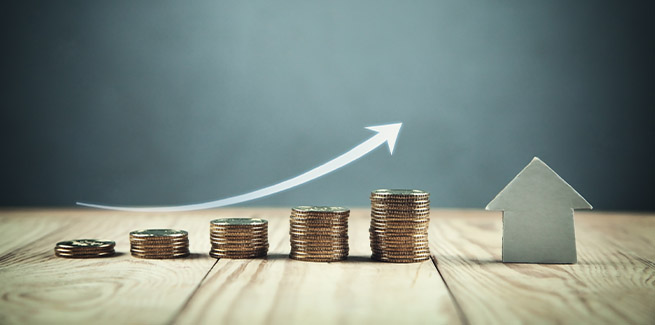CoreLogic’s latest Pain and Gain report has revealed that 91.5 per cent of property resales during the June quarter recorded a nominal profit-making gain from the previous purchase price.
This represents the highest level of profitability in just over a decade.
The report attributed the record rate of profitability to tight property listings, record-low mortgage rates, and “extraordinary” growth in housing values.
Nationally, profit-making residential property sales have increased for four consecutive quarters, according to the report author, CoreLogic’s head of research Eliza Owen.
The report – which has analysed the proportion of housing resales that delivered nominal gains or losses to sellers – is based on around 106,000 dwelling resales in the June quarter, a 9 per cent increase compared with the March 2021 quarter.
The typical median hold period on all resales for the quarter was 8.8 years, with a national median gross resale profit of $265,000. Median gross losses of $43,000 were recorded during the same period.
Nevertheless, Ms Owen said that the recent substantial growth in the market allowed property owners who were reselling after only two years to pocket a median return of $123,000.
“For those cashing in after over 30 years of holding a property, the median return was $712,000,” she said.
“Such high levels of profitability may start to encourage vendor participation and bring down typical hold periods, especially as major cities navigate a path out of 2021 lockdowns.”
Regional markets achieve record profitability
The high rates of resale profitability were evident across regional and tree-change markets, a trend that has continued in 2021.
Regional Victoria’s Ballarat SA4 region achieved a record high rate of profitability, with 99.7 per cent of resales recording a profit in the June quarter.
The record-high rates of profitability extended to regional Victoria’s entire dwelling market, where 98.7 per cent of resales were above the purchase price.
Sydney house resales achieved the highest level of profit-making resales since 1982, at 97.6 per cent, according to the report.
Ms Owen noted that even markets with relatively elevated levels of loss-making resales saw significant improvement through the June quarter.
For example, the rate of loss-making declined by 4.6 percentage points across Perth in the June quarter and 4.7 percentage points across Darwin.
However, Ms Owen flagged that profit-making resales were not occurring across Australia, “as pockets of risk and high concentrations of nominal loss were recorded in specific locations”.
CoreLogic’s analysis of local government area housing markets has revealed a high rate of loss-making resales across inner-city areas such as Perth (63.5 per cent), Darwin (39.3 per cent), and Melbourne (34.8 per cent).
Loss-making sales were affected by border closures and weak inner-city rental markets, Ms Owen said.
In the June 2021 quarter, 93.9 per cent of owner-occupied resales made a nominal gain, compared with 87.7 per cent of investor resales.
Despite investors accounting for 28.0 per cent of total resales in the quarter, investor sales comprised only 26.6 per cent of profit-making resales, and 44.1 per cent of loss-making resales in the June quarter.
Owner-occupier resales accounted for 55.9 per cent of loss-making sales, but 73.4 per cent of total resales in the quarter.
Owner-occupiers had a median nominal gain on resales of $295,000 compared to $200,000 for investors.
“This may largely be because the higher proportion of house resales are by owner-occupiers, while investors saw a larger volume of unit resales than houses through the June quarter,” the report said.
“Houses usually have inherently higher value than units, and in the past decade have seen higher annualised growth rates at the national level (at 5.2 per cent) than units (3.5 per cent).”
Units continue loss-making at higher levels
While profitability across both the house and unit market increased through the June 2021 quarter, the incidence of loss-making sales remained considerably higher across the unit segment.
In the three months to June, 15.3 per cent of units sold for a loss, down from 16.6 per cent in the previous quarter, and 21.0 per cent from the same quarter last year.
In comparison, the loss-making sale rate in the house segment was 5.6 per cent, down from 6.6 per cent in the previous quarter, and 11.6 per cent in the June 2020 quarter.
Recent data from BIS Oxford Economics and QBE Lenders’ Mortgage Insurance revealed that median unit prices have been forecast to grow by 19.1 per cent between now and 2024 in Sydney to almost $1 million (after rising by 7.8 per cent to $837,600 in 2021), and 16.1 per cent in Melbourne to over $731,000 (after growing by 5.5 per cent to $630,400 in 2021).
The forecasts are based on an expected return of migration flow once international borders reopen in Australia as it hits vaccination targets, which could see rental demand increase, leading to a rise in investors purchasing property (particularly units).
Home values rising at fastest pace since 1989
CoreLogic’s national home value index rose another 1.5 per cent in September, taking housing values 17.6 per cent higher over the firs nine months of the year, and 20.3 per cent higher over the past 12 months.
The annual growth is tracking at the fastest pace since the year ending June 1989, according to the property research group.
Hobart (2.3 per cent) and Canberra (2.0 per cent) recorded the largest growth across the capital cities, while Darwin (0.1 per cent), and the recently revised Perth index (0.3 per cent) recorded the softest growth conditions.
Despite positive growth conditions, the figures have indicated that the housing market has moved past the March growth rate peak when national dwelling values increased by 2.8 per cent. Since then, the monthly growth rate has softened to 1.5 per cent.
According to CoreLogic research director Tim Lawless, the slowing growth conditions have been driven by higher barriers of entry for first home buyers, and fewer government incentives to enter the market.

